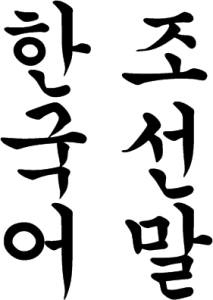By Sarah-Claire Jordan
 With all of the political turmoil going on between the U.S. and North Korea, the country and its southern counterpart have become part of the American consciousness. In terms of entertainment, music and TV shows made in South Korea have become increasingly popular outside of the country, including in the U.S. With these two different perspectives of the language and culture of Koreans, it might seem difficult to cut through everything and see what North and South Korea are really about.
With all of the political turmoil going on between the U.S. and North Korea, the country and its southern counterpart have become part of the American consciousness. In terms of entertainment, music and TV shows made in South Korea have become increasingly popular outside of the country, including in the U.S. With these two different perspectives of the language and culture of Koreans, it might seem difficult to cut through everything and see what North and South Korea are really about.
One way to do that, however, is to look at the language they share. Here are four things that most people may not know about Korean:
1. Korean could be a language isolate
For the most part, linguists agree that Korean is probably a language isolate, meaning there are no other languages that it is related to genetically. Another way to put that is to say that Korean shares no linguistic ancestors with any other languages. There has been some interest in a hypothesis that Japanese and Korean may be related, but that could just come down to the two languages borrowing words from each other due to proximity. A handful of linguists think Korean may be an Altaic language, the same language family that includes Turkish and Mongolian, among others. Ultimately, there isn’t enough evidence to prove that Korean isn’t a language isolate.
2. The Korean writing system was originally based on that of Chinese
Up until about 1446, Korean was written using Chinese characters, either to represent similar syllables or synonyms, called “Hyanchal”. However, nowadays Korean is written using the Korean alphabet, known as “Hangul” in South Korea and “Chosŏn’gŭl” in North Korea. This alphabet was developed in 1443 during the Joseon Dynasty. Sejong the Great is responsible for promoting its use in 1446, and it is used by all Korean speakers today.
3. Gender is a big factor in how Korean is used
Though in English and many other languages the gender of the person speaking has very little effect on the way they speak, Korean is a different story. Male speakers don’t generally have to modify anything when they speak, and would speak a kind of “default” Korean, but women modify their tone so it sounds softer as well as other things. A woman would introduce to herself in reference to her family or husband rather than using her actual name and generally use more rising tones in their statements, or add on a tag question at the end, all in the name of not seeming so assertive. On top of that, the words for job titles are different for men and women, even if they aren’t jobs normally done by one gender or the othe.r
4. The Korean spoken in North Korea differs from that of South Korea
Though there are different dialects of Korean depending on the region, there are two different standard dialects, one used in North Korea and the other in South Korea. Both standard dialects are based on the dialect spoken in Seoul, the capital city of South Korea. The two standard dialects differ in pronunciation, spelling, grammar, and vocabulary, with many of the differences being influenced by the conservative government of North Korea. For instance, in South Korea you are much more likely to hear English loanwords than in North Korea.
For an overview of our multilingual Desktop Publishing services, visit our Desktop Publishing and Design page



